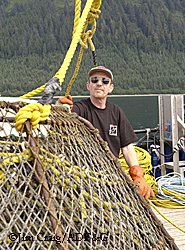Alaska Fish & Wildlife News
December 2008
Medeia cuts fuel consumption 30 percent
Saves Thousands

Skyrocketing fuel costs last winter sent the captain and crew of the R/V Medeia searching for a sweet spot. They found it, and passed about $40,000 in savings on to Alaska biologists.
The Fish and Game research vessel consumes about 30,000 gallons of fuel during the work season. Last winter, with fuel costs above $4.00 /gallon, Captain Russell Sandstrom was eager to fine-tune the operation of the Medeia.
“Last winter we were watching fuel prices going up, and we bought a set of fuel meters that allowed us to judge fuel consumption very accurately in real time,” Sandstrom said.
It looks like we managed to reduce our consumption by about 30 to 35 percent, Sandstrom said. And basically, we did it by slowing down about one knot, 10 percent less from our normal cruise speed.
The Media is a 110-foot steel boat, built in 1982 in Louisiana to conduct geophysical work in the Gulf of Mexico. It was acquired by ADF&G in 1992. Five engines power the vessel: two main Detroit Diesel engines, two generators, and one engine dedicated to the hydraulics. The two main engines burn the majority of the fuel.
Fish and Game biologists use the Medeia, as do NOAA scientists, and the two agencies also conduct joint ventures. The boat is used for a variety of projects including shellfish surveys (for king and tanner crabs, and shrimp), Seymour Canal herring fisheries management, and juvenile salmon trawling in Icy Strait for NOAA’s pink and chum salmon forecasts.
The crew had all the fuel curves and information from the manufacturers, but they wanted to do their own tests comparing speed to fuel consumption and find a “sweet spot” for fuel efficiency. The standard, accepted cruise speed for years has been 9 ½ knots, running at 1460 rpms. The engines use about 32 gallons of fuel an hour when underway at that speed.

Slowing the speed to 8 ½ knots and running at 1250 rpms reduced fuel consumption to just 19 gallons per hour.
Sandstrom said they had parameters – they couldn’t slow down so much that it affected the research or the logistics of the projects. “We couldn’t slow down to three knots and double the length of the trip,” Sandstrom said. “It couldn’t have a negative impact on the work day.”
Sandstrom said the Medeia tops out at about 11 ½ knots, but running at “warp speed” would push fuel consumption up to a whopping 60 gallons/hour.
Researchers conduct almost identical surveys year after year, allowing Sandstrom to make comparisons. During a 10-day red king crab trip to Icy Straits and Peril Straits in 2007 they burned 2,700 gallons of fuel at a cost of $2.39/gallon. That cost $6,445.
The same 10-day trip in 2008 burned 2,030 gallons of fuel, but this past July the price of fuel was at a high of $4.54/gallon, almost double the previous year. Fuel cost for that trip ran almost $9,000. Sandstrom pointed out that had they burned that extra 700 gallons of fuel, the trip’s cost would’ve been far higher, around $11,000.
The research projects are charged for fuel, and fuel savings are passed on to the projects, which allow them to get more work done, or have money left for other things.
Those fuel savings are paying off this month for Fish and Game shellfish biologists. Every year, biologists and resource managers working with crab in Alaska gather in Anchorage for the Interagency Crab Meeting. “This year we weren’t going to be able to go because we didn’t have enough money,” said Fish and Game shellfish biologist Julie Bednarski. “But because Russell saved us so much from the fuel, we could go.”

Sandstrom shares the credit with his crew, Bob Frampton, Jim deLabruere and Rick Gottwald. “This was a collaborative effort of the whole crew,” Sandstrom said. “They all contributed good ideas and participated to make it happen.”
Sandstrom said he’s considered other ways to improve efficiency in the past, including repowering the Medeia with new engines. It just isn’t cost effective, he said. The two Detroit Diesels aren’t quite as efficient as new engines, but they’re not bad.
“This is World War Two era technology,” he said. “They aren’t state of the art engines, but they are built really robust, bullet-proof, and they really last.”
New engines cost $400,000 to $500,000, and the department would never recoup those costs simply in improved fuel efficiency. “This is something we could do,” he said. “We could slow down more, but if we started adding more sea days, more travel time and a longer crew work day it doesn’t pay off. We’ve turned a 10 hour trip into an 11 hour trip and it’s not bad at all, it’s seamless as far as the work goes.”
“Another benefit we didn’t count on is how much quieter the boat is,” he said. “I can’t say exactly what the decibel drop is, but everyone notices it. It reduces stress and makes it easier to work, especially on deck.”
Riley Woodford is a writer with Fish and Game. He
spent a day aboard the Medeia with a bunch of young Steller sea lions one Halloween a few years back, but that's another story.
Subscribe to be notified about new issues
Receive a monthly notice about new issues and articles.
